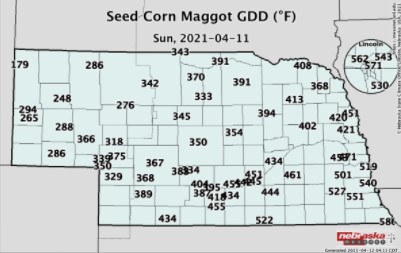By Robert Wright
In the past few years, we have received several reports of injury from seed corn maggot that has reduced stands of Nebraska soybeans. The greatest risk for seed corn maggot injury is when a green manure or animal manure is incorporated just before planting. The female flies are attracted to lay eggs on sites with decaying organic matter. The seed corn maggot will also feed on germinating crop seeds and can reduce seedling vigor and, if abundant enough, reduce plant stands. In many cases this year, recently killed cover crops may have attracted seed corn maggot to lay eggs in the affected fields.
The following University of Minnesota recommendations can help minimize injury from seed corn maggots.

Current degree-day information for seed corn maggot is now available at Nebraska Mesonet.
Cultural Control